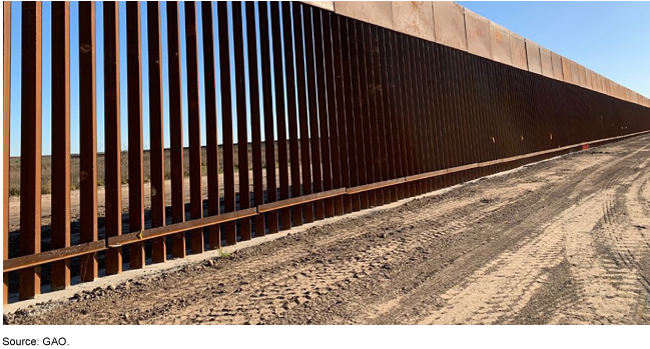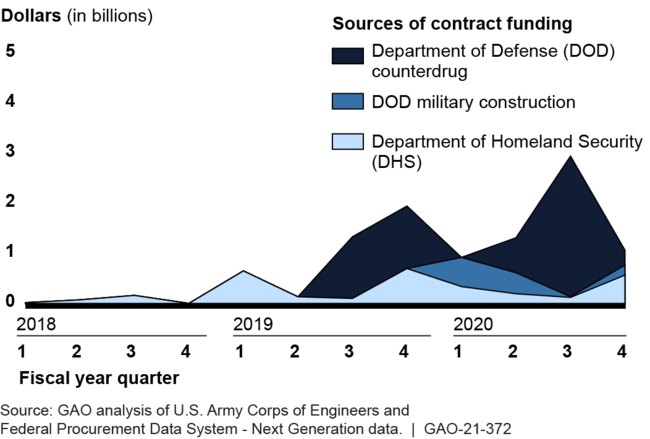Southwest Border: Schedule Considerations Drove Army Corps of Engineers' Approaches to Awarding Construction Contracts through 2020
Fast Facts
Army Corps of Engineers received DOD and other funds to construct barriers on the southwest U.S. border. With tight time frames to award some of the DOD-funded construction contracts, the Corps:
- Awarded $4.3 billion in noncompetitive contracts. (Competition helps ensure the government gets a good price; noncompetitive contracts can be more expensive.)
- Awarded several contracts that started work before finalizing terms (like cost).
We recommended that the Corps assess its contracting approaches and acquisition plans going forward.
Newly constructed border barriers in Starr County, Texas

Highlights
Why This Matters
Following a 2019 Presidential Declaration of National Emergency, billions of dollars were made available for the U.S. Army Corps of Engineers' use on border barrier construction. This report provides information on the Corps' contracting for border barriers during fiscal years 2018–2020.
Key Takeaways
Some Department of Defense funding was only available for a short time before expiring, giving the Corps a tight schedule for awarding contracts. This—and the emergency declaration—led the Corps to depart from its planned acquisition approach.
The Corps focused on starting construction quickly and maximizing the miles of border barrier panels it could build. To do so, it:
- Awarded $4.3 billion in noncompetitive contracts. Competition helps ensure the government gets a good price.
- Started work before agreeing to terms. The Corps awarded several contracts before terms, such as barrier specifications and cost, were finalized.
By focusing on expediency in contracting, the government risks paying higher costs.
Contractors completed most DOD-funded border barrier panels by the end of December 2020 as scheduled. A January 2021 Presidential Proclamation paused border barrier construction to the extent permitted by law, and called for a review. In March 2021, DOD officials said they gave input to the Office of Management and Budget, and OMB will present a plan to the President.
The Corps has not developed plans to examine its overall acquisition approach and identify lessons learned. Without doing so, the Corps could miss opportunities to strengthen its contracting strategies in future border support efforts.
Border Barrier Obligations, Fiscal Years 2018–2020

How GAO Did This Study
We reviewed all of the border barrier construction contracts the Corps awarded for projects from fiscal years 2018 through 2020. We also reviewed relevant federal procurement data and interviewed Corps and Department of Homeland Security officials.
Recommendations
The Corps should assess the approaches used to build the border barriers and, as appropriate, reassess its acquisition strategy going forward. The Corps concurred with our recommendation.
Recommendations for Executive Action
| Agency Affected | Recommendation | Status |
|---|---|---|
| Corps of Engineers | The Commanding General of the U.S. Army Corps of Engineers should conduct an assessment of the approaches used to build the border barriers and, as appropriate, reassess its acquisition strategy going forward. (Recommendation 1) |
The U.S. Army Corps of Engineers (USACE) agreed with GAO's recommendation. In December 2021, USACE officials conducted an after action review of the contracting response following the 2019 Presidential Declaration of National Emergency. This review was centered around the findings in GAO's report and the recommendation. The review considered actions required to improve contracting methods for future national emergency declarations.
|
